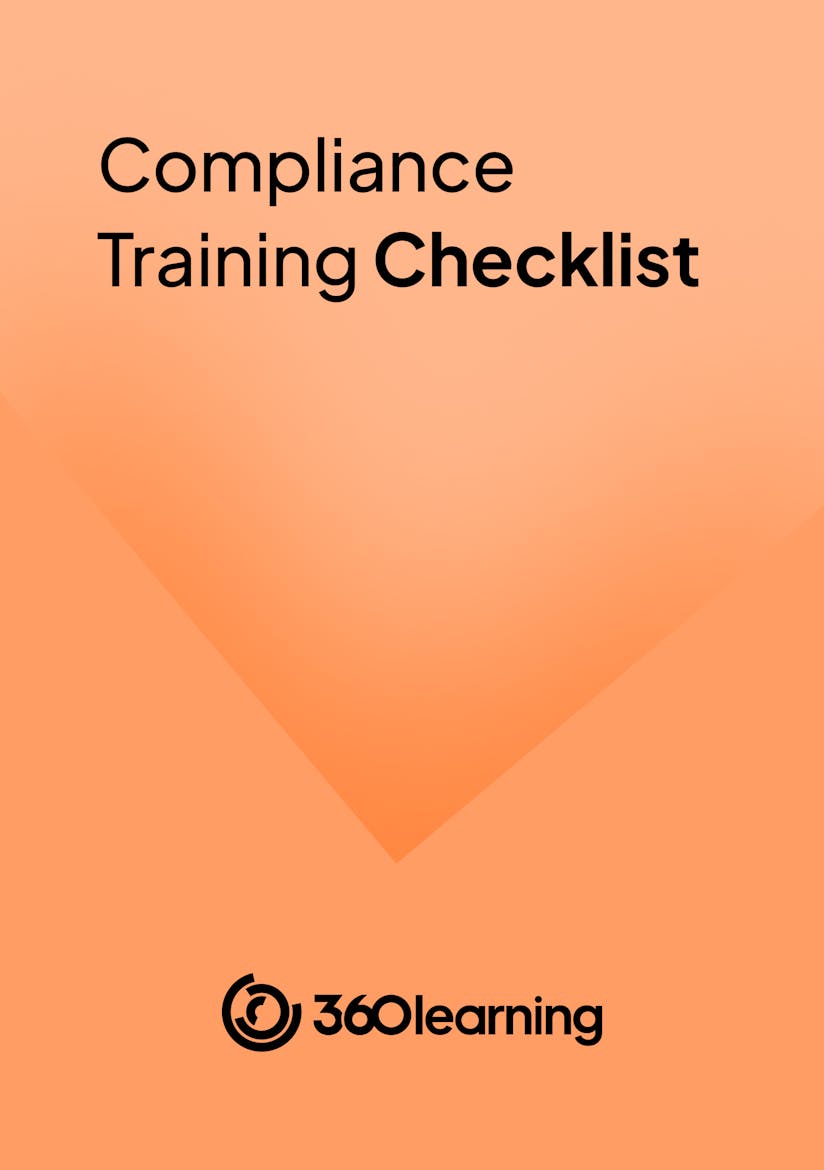
For too long, compliance training has felt more like a punishment than a reason for excitement. Scores of employees slog through long and painful presentations, working harder to stay awake than to actually avoid risk.
Teams pay just enough attention to pass the “test” and get back to their real work.
For something as critical as risk management, that’s a shame. But who can blame them when the material is boring and generic, and there’s little real incentive to engage?
At long last, that’s changing. Today, compliance training can be fun, informative, and impactful. A smart course with the right delivery can save companies billions in legal and regulatory trouble down the line.
So how do you build a worthwhile and engaging compliance training? Let’s see what some of the best practitioners prioritize.

One lawsuit is all it takes - why investing in compliance training is worth it
By providing your contact info, you agree to receive communications from 360Learning. You can opt-out at any time. For details, refer to our Privacy Policy.
Why take compliance training seriously?
Compliance training is too often an afterthought in busy companies. You’re focused on creating new products and growing the business, and compliance can feel like an inconvenient hurdle slowing you down.
But organizations have good reasons to engage in regular compliance training. These include:
- Regulatory requirements. Particularly in industries like finance or healthcare, companies must ensure employees have completed minimum training requirements.
- Legal protection. Beyond ticking the regulatory boxes (above), training helps ensure that employees are aware of and adhere to laws and regulations. This should help to reduce the risk of awkward letters, added lawyer’s fees, and unnecessary fines.
- Risk avoidance. The potential for risk goes beyond purely legal issues. It includes the potential for penalties, the loss of partners, and breaching customers’ hard-earned trust. Educate employees on compliance issues such fraud, data breaches, and other violations that could harm the business.
- Reputation management. Whether intentional or not, you have a precious brand reputation to defend. People won’t work with or buy from you if they don’t believe you’re trustworthy. Effective compliance training prevents unethical behavior and ensures that employees uphold your brand values.
- Operational efficiency: While some see compliance training as a hindrance, a serious compliance breach is far worse. Good training helps standardize procedures and ensures that everyone is on the same page, leading to smoother operations and fewer disruptions.
In short, compliance training is an excellent investment to manage a whole range of risks. So how can you make it as useful and engaging as possible?
8 compliance training best practices
There are countless ways to make compliance training more effective and engaging. Here are eight that we see working in successful organizations every day.
1. Offer role-specific training
The first key question is: who needs what training? There’s almost certainly a base layer of information and boundaries that apply to every team member, but then some further details will be job-dependent.
For example, your HR team and hiring managers need to know what’s permitted during job interviews, and perhaps some specific DEI training. But for most employees, this information is overkill and a distraction.
Similarly, fintech product developers may need intricate knowledge of anti-money laundering rules to ensure the product identifies risky transactions. Meanwhile, the whole organization could use some key considerations and ways to spot fraud or misdeeds, just not at the same level of granularity.
Tailor compliance training to the specific roles and responsibilities within the organization. This not only keeps individuals engaged and focused, but also makes the L&D pro’s load lighter since every training is delivered where it actually helps.
2. Make training modules interactive
Nobody likes a long lecture. And the same goes for lengthy Zoom calls and endless Powerpoints. And while compliance training certainly has the potential to be boring and repetitive, it shouldn’t be.
Use gamified e-learning modules that incorporate quizzes, scenarios, and rewards to make learning about compliance more engaging and memorable.
For example, Zotec Partners built a compliance training escape game to hook learners in. And the result: over 92% completion rates for this course.
“We had learners telling us it was the best compliance training they’d ever taken from any company,” says Zotec Director of L&D Jennifer Weldy. “It made us want to look at the next compliance course and think about how we could make it fun and interactive as well, but not repeating the same escape room format.”
You may be somewhat limited in what you have to cover in your compliance training — certain rules and regulations you need to cover. But there’s no limit to the fun and creativity you can imbue your programs with.
3. Illustrate with real-life examples
Rules and regulations can feel abstract and hard to relate to. If your team members can’t imagine a compliance breach in their day to day, they’re likely to tune out and won’t retain the information.
It’s an obvious but effective best practice: always provide real-world examples.
Here’s a high-profile example. Most companies with a European presence need to provide GDPR training to staff. You’ll explain how important it is to take customer data seriously and be careful when processing user information. Which everyone understands, but it’s a little tricky to know how and when this applies (other than always).
To illustrate, why not talk about Meta? In 2023, the parent company of Facebook and Instagram received a €1.2 billion fine for the way it shared user data between Europe and the US. This shows the importance not just of handling data carefully on a case-by-case basis, but in actually designing compliant architecture for your entire company.
Even better, make your examples as specific and relevant to your own industry as possible. This makes the material more relatable and meaningful.
4. Incentivize completion & ongoing compliance
Everybody loves a challenge, particularly when it comes with rewards. L&D pros know just how impactful it can be to recognize participation in any training course.
The first person, team, or department to complete your compliance training wins a prize. That prize can be physical, but it can also be recognition in company channels. Whatever will have the biggest impact.
Gamification is great here too. Employees love earning badges or increasing their own scores as they progress through courses.
Recognize and reward teams or individuals who consistently adhere to compliance standards, fostering a positive attitude towards these practices.
Just be mindful of the company culture and interpersonal dynamics before putting too much emphasis on competition. Some teams may respond better to a group incentive, and some individuals may become unengaged if they don’t have a realistic chance to win.
5. Keep it simple
Here’s another fairly obvious observation: what seems simple and clear to your compliance experts may feel like rocket science to other team members. Particularly as you get into the nitty gritty of financial regulations or legal frameworks, it can quickly feel like homework.
Break down complex compliance topics into simpler, more digestible pieces to avoid overwhelming team members. And ask yourself the following questions as you design each course:
- What do employees absolutely need to know to avoid risk?
- What’s the simplest and fastest way to deliver this information?
- What’s the most logical way to break this training down into smaller pieces, without filling everyone’s calendars or bugging the whole team?
You may also need to remind subject-matter experts that not everyone knows or enjoys this topic as much as they do. Encourage them to make it fun, and keep it brief.
6. Get the right training tools
The delivery methods for compliance training have come a long way. While there’s still room for presentations and Q&A sessions, we can do better. You can now automate much of the course building, update material dynamically, and test team members on an ongoing basis with very little effort.
And some of the compliance training best practices we’ve seen will be hard (or impossible) without good tools. Gamification makes such a big difference, but it’s hard to build on our own.
The right LMS tool makes all company learning easier and more scalable, including compliance training. The best compliance training software lets you:
- Build courses at scale with AI-empowered authoring tools
- Generate quizzes and games in a few clicks
- Combine mandatory company-wide training with role-specific curricula
- Integrate off-the-shelf compliance training content with your own in-house material
- Work asynchronously or in-person, and easily track attendance and completion either way
Truthfully, the list of benefits just keeps going. Any organization that regularly needs to deliver compliance training is missing out without the right software.
7. Provide regular refreshers
Compliance rules and regulations change, and so does your workforce. So you need to keep up to date on both counts.
Every new employee needs compliance training in line with their role. Hopefully you have a tool (see above) or process to deliver that training without involving your compliance officer in every induction. At the very least, make this a formal part of the onboarding process, and not something done ad hoc when you realize that team members need it.
And those who’ve already done the core training still need updates. Provide bite-sized refresher sessions to keep compliance topics top of mind, rather than relying on annual, lengthy keynotes. The more business-critical a particular compliance topic is, the less you can afford to ignore it for long periods.
A simple suggestion: send monthly or quarterly quizzes to keep team topics top of mind. A 5-minute quiz with a few potential scenarios — risks to avoid or major cases from the news — is an excellent refresher.
8. Maintain a culture of compliance
The final best practice relates more to what you do between training sessions. You need employees to take compliance seriously — to live and breathe it in their day to day.
Foster a company culture where compliance is seen as a shared responsibility and integral part of the business, rather than a burdensome obligation. And certainly not just a box-ticking training course to be endured.
Some of this comes from senior leadership. Managers and executives should be among the first to take these trainings, and should really know the material.
And some of this comes back to incentivizing the right behavior. That applies every single day, and not only during training. Give kudos to people who make the right choices. Share company success stories, and highlight risks that were narrowly avoided.
Perhaps most importantly, make time for this work. Compliance training shouldn’t be a lunchtime activity or left for a quiet Friday afternoon. Give it pride of place, and show that maintaining high standards is actually the baseline for your organization.
Give your team the best compliance training experience
Compliance training is really no different from any other form of learning and development. As with any course, you can expect mixed levels of exciting and different speeds of learning.
Which means building a single, generic compliance course is never a great idea.
Instead, find ways to deliver training that meets team members in their own role, on their own schedule, and with incentives they actually crave. That sounds like a pipe dream, but it’s really just a matter of the right tooling.
A platform like 360Learning takes compliance training beyond what you’re used to. Gone are the boring sessions and long course-building times. You can produce interactive, insightful courses in minutes, and update easily to keep up with the industry. Team members can track their progress, earn badges and rewards, and managers can automatically encourage their team to complete training.
Compliance is something to cherish, not a chore. Get serious about risk management, and have fun while doing it.



